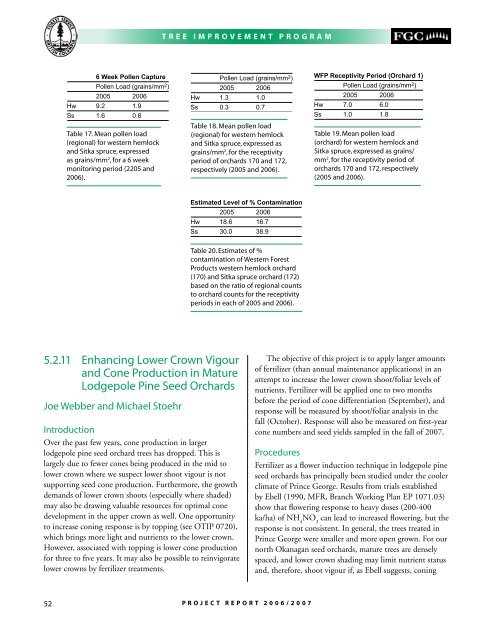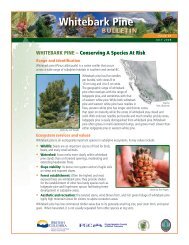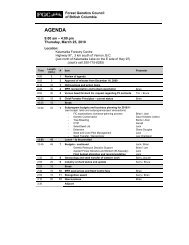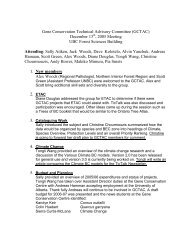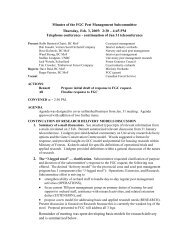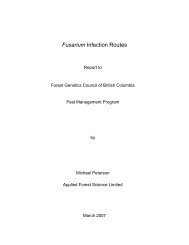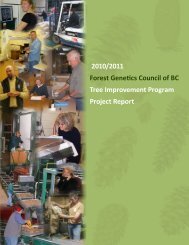Tree Improvement Program Project Report 2006 / 2007
Tree Improvement Program Project Report 2006 / 2007
Tree Improvement Program Project Report 2006 / 2007
Create successful ePaper yourself
Turn your PDF publications into a flip-book with our unique Google optimized e-Paper software.
2<br />
Table 1: Mean pollen load (regional) T R E E I M P R O V E M E N T P R O G R A M<br />
for western hemlock and Sitka spruce,<br />
expressed as grains/mm2 Table 2: Mean pollen load (regional)<br />
for western hemlock and Sitka spruce,<br />
expressed as grains/mm<br />
, for a 6 week<br />
monitoring period (2005 and <strong>2006</strong>).<br />
2 Table 3: Mean pollen load (orchard)<br />
for western hemlock and Sitka spruce,<br />
, for the expressed as grains/mm<br />
receptivity period of orchards 170 and<br />
172, respectively (2005 and <strong>2006</strong>).<br />
2 , for the<br />
receptivity period of orchards 170 and<br />
172, respectively (2005 and <strong>2006</strong>).<br />
6 Week Pollen Capture<br />
Pollen Load (grains/mm 2 )<br />
2005 <strong>2006</strong><br />
Hw 9.2 1.9<br />
Ss 1.6 0.8<br />
Table 17. Mean pollen load<br />
(reg onal) for western hemlock<br />
and S tka spruce, expressed<br />
as gra ns/mm 2 , for a 6 week<br />
mon tor ng per od (220 and<br />
<strong>2006</strong>).<br />
Pollen Load (grains/mm 2 )<br />
2005 <strong>2006</strong><br />
Hw 1.3 1.0<br />
Ss 0.3 0.7<br />
Table 1 . Mean pollen load<br />
(reg onal) for western hemlock<br />
Table and S4: tka Estimates spruce, expressed of % contamination as<br />
for Western Forest Products western<br />
gra ns/mm<br />
hemlock orchard (170) and Sitka spruce<br />
orchard (172) based on the ratio of<br />
regional counts to orchard counts for<br />
the receptivity periods in each of 2005<br />
and <strong>2006</strong>.<br />
2 , for the recept v ty<br />
per od of orchards 170 and 172,<br />
respect vely (200 and <strong>2006</strong>).<br />
Estimated Level of % Contamination<br />
2005 <strong>2006</strong><br />
Hw 18.6 16.7<br />
Ss 30.0 38.9<br />
.2.11 Enhanc ng Lower Crown V gour<br />
and Cone Product on n Mature<br />
Lodgepole P ne Seed Orchards<br />
Joe Webber and M chael Stoehr<br />
Introduct on<br />
Over the past few years, cone production in larger<br />
lodgepole pine seed orchard trees has dropped. This is<br />
largely due to fewer cones being produced in the mid to<br />
lower crown where we suspect lower shoot vigour is not<br />
supporting seed cone production. Furthermore, the growth<br />
demands of lower crown shoots (especially where shaded)<br />
may also be drawing valuable resources for optimal cone<br />
development in the upper crown as well. One opportunity<br />
to increase coning response is by topping (see OTIP 0720),<br />
which brings more light and nutrients to the lower crown.<br />
However, associated with topping is lower cone production<br />
for three to five years. It may also be possible to reinvigorate<br />
lower crowns by fertilizer treatments.<br />
Table 20. Est mates of %<br />
contam nat on of Western Forest<br />
Products western hemlock orchard<br />
(170) and S tka spruce orchard (172)<br />
based on the rat o of reg onal counts<br />
to orchard counts for the recept v ty<br />
per ods n each of 200 and <strong>2006</strong>).<br />
P R O J E C T R E P O R T 2 0 0 6 / 2 0 0 7<br />
WFP Receptivity Period (Orchard 1)<br />
Pollen Load (grains/mm 2 )<br />
2005 <strong>2006</strong><br />
Hw 7.0 6.0<br />
Ss 1.0 1.8<br />
Table 19. Mean pollen load<br />
(orchard) for western hemlock and<br />
S tka spruce, expressed as gra ns/<br />
mm 2 , for the recept v ty per od of<br />
orchards 170 and 172, respect vely<br />
(200 and <strong>2006</strong>).<br />
The objective of this project is to apply larger amounts<br />
of fertilizer (than annual maintenance applications) in an<br />
attempt to increase the lower crown shoot/foliar levels of<br />
nutrients. Fertilizer will be applied one to two months<br />
before the period of cone differentiation (September), and<br />
response will be measured by shoot/foliar analysis in the<br />
fall (October). Response will also be measured on first-year<br />
cone numbers and seed yields sampled in the fall of <strong>2007</strong>.<br />
Procedures<br />
Fertilizer as a flower induction technique in lodgepole pine<br />
seed orchards has principally been studied under the cooler<br />
climate of Prince George. Results from trials established<br />
by Ebell (1990, MFR, Branch Working Plan EP 1071.03)<br />
show that flowering response to heavy doses (200-400<br />
ka/ha) of NH 4 NO 3 can lead to increased flowering, but the<br />
response is not consistent. In general, the trees treated in<br />
Prince George were smaller and more open grown. For our<br />
north Okanagan seed orchards, mature trees are densely<br />
spaced, and lower crown shading may limit nutrient status<br />
and, therefore, shoot vigour if, as Ebell suggests, coning


